
Camouflage is the use of any combination of materials, coloration, or illumination for concealment, either by making animals or objects hard to see, or by disguising them as something else. Examples include the leopard's spotted coat, the battledress of a modern soldier, and the leaf-mimic katydid's wings. A third approach, motion dazzle, confuses the observer with a conspicuous pattern, making the object visible but momentarily harder to locate, as well as making general aiming easier. The majority of camouflage methods aim for crypsis, often through a general resemblance to the background, high contrast disruptive coloration, eliminating shadow, and countershading. In the open ocean, where there is no background, the principal methods of camouflage are transparency, silvering, and countershading, while the ability to produce light is among other things used for counter-illumination on the undersides of cephalopods such as squid. Some animals, such as chameleons and octopuses, are capable of actively changing their skin pattern and colours, whether for camouflage or for signalling. It is possible that some plants use camouflage to evade being eaten by herbivores.

Dazzle camouflage, also known as razzle dazzle or dazzle painting, is a family of ship camouflage that was used extensively in World War I, and to a lesser extent in World War II and afterwards. Credited to the British marine artist Norman Wilkinson, though with a rejected prior claim by the zoologist John Graham Kerr, it consisted of complex patterns of geometric shapes in contrasting colours interrupting and intersecting each other.

Abbott Handerson Thayer was an American artist, naturalist, and teacher. As a painter of portraits, figures, animals, and landscapes, he enjoyed a certain prominence during his lifetime, and his paintings are represented in major American art collections. He is perhaps best known for his 'angel' paintings, some of which use his children as models.

William Andrew Mackay was an American artist who created a series of murals about the achievements of Theodore Roosevelt. Those three murals, completed in 1936, were installed beneath the rotunda in the Roosevelt Memorial Hall of the American Museum of Natural History in New York. Less known but also important, he was a major contributor to the development of ship camouflage in the United States during World War I.
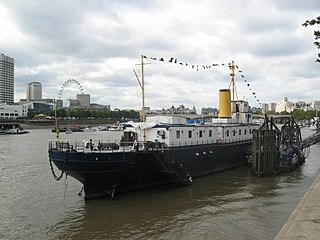
HMS President is a retired Flower-class Q-ship that was launched in 1918. She was renamed HMS President in 1922 and moored permanently on the Thames as a Royal Navy Reserve drill ship. In 1982 she was sold to private owners and, having changed hands twice, served as a venue for conferences and functions as well as the offices for a number of media companies. She has been moved to Chatham on the Medway in Kent since 2016, but is due to return to the capital. She had the suffix "(1918)" added to her name in order to distinguish her from HMS President, the Royal Naval Reserve base in St Katharine Docks. She is one of the last three surviving Royal Navy warships of the First World War. She is also the sole representative of the first type of purpose built anti-submarine vessels, and is the ancestor of World War II convoy escort sloops, which evolved into modern anti-submarine frigates.

Military camouflage is the use of camouflage by an armed force to protect personnel and equipment from observation by enemy forces. In practice, this means applying colour and materials to military equipment of all kinds, including vehicles, ships, aircraft, gun positions and battledress, either to conceal it from observation (crypsis), or to make it appear as something else (mimicry). The French slang word camouflage came into common English usage during World War I when the concept of visual deception developed into an essential part of modern military tactics. In that war, long-range artillery and observation from the air combined to expand the field of fire, and camouflage was widely used to decrease the danger of being targeted or to enable surprise. As such, military camouflage is a form of military deception in addition to cultural functions such as political identification.
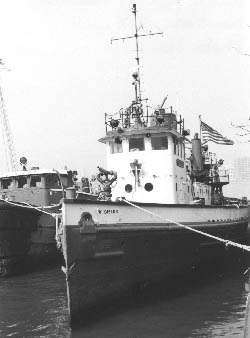
John J. Harvey is a fireboat formerly of the New York City Fire Department (FDNY) in New York City, famed for returning to service following the September 11, 2001 attacks. She is one of the most powerful fireboats ever built, capable of pumping up to 18,000 gallons of water a minute.

Everett Longley Warner was an American Impressionist painter and printmaker, as well as a leading contributor to US Navy camouflage during both World Wars.
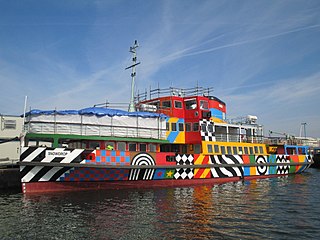
The Dazzle ships of the 14–18 NOW project are artworks created to commemorate the work of the artists and artisans who developed and designed the dazzle camouflage used in the First World War by ships as a defence against U-boat attack.

Norman Wilkinson was a British artist who usually worked in oils, watercolours and drypoint. He was primarily a marine painter, but also an illustrator, poster artist, and wartime camoufleur. Wilkinson invented dazzle painting to protect merchant shipping during the First World War.
The Paula Cooper Gallery is an art gallery in New York City, founded in 1968 by Paula Cooper.
Harold Van Buskirk was an American architect and fencing champion, and a three-time member of the US Olympic fencing team. During World War I, he was the officer in charge of the US Navy Camouflage Section, which designed and tested camouflage for American ships, both military and civilian.
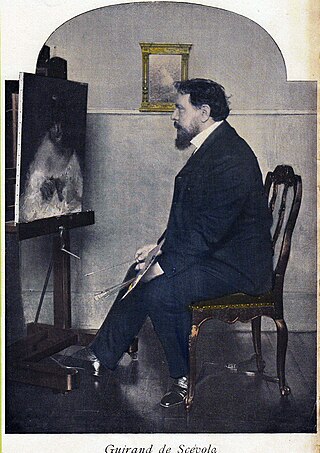
Lucien-Victor Guirand de Scévola was a French painter. He is known for his pioneering leadership of the Camoufleurs in World War I.

Steven Barry Sykes was a British artist, known for his Gethsemane Chapel in the rebuilt Coventry Cathedral. He was active in the British desert camouflage unit in the Second World War, and was responsible for the dummy railhead at Misheifa and for the effective camouflage and large-scale military deception in the defence of Tobruk in 1942.
Tauba Auerbach is a visual artist working in many disciplines including painting, artists' books, sculpture, and weaving who lives and works in New York.
Roy Richard Behrens is an American artist and academic who is an emeritus professor of art and distinguished scholar at the University of Northern Iowa. He is well known for his writings on camouflage in relation to art, design and creativity as detailed in Camoupedia and additional books and essays on the subject.
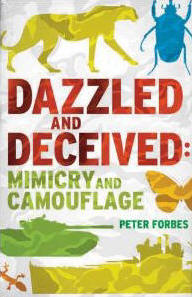
Dazzled and Deceived: Mimicry and Camouflage is a 2009 book on camouflage and mimicry, in nature and military usage, by the science writer and journalist Peter Forbes. It covers the history of these topics from the 19th century onwards, describing the discoveries of Henry Walter Bates, Alfred Russel Wallace and Fritz Müller, especially their studies of butterflies in the Amazon. The narrative also covers 20th-century military camouflage, begun by the painter Abbot Thayer who advocated disruptive coloration and countershading and continued in the First World War by the zoologist John Graham Kerr and the marine artist Norman Wilkinson, who developed dazzle camouflage. In the Second World War, the leading expert was Hugh Cott, who advised the British army on camouflage in the Western Desert.
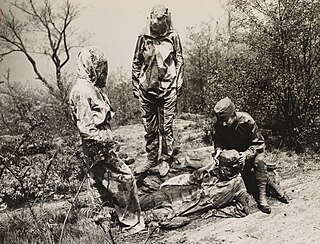
The Women's Reserve Camouflage Corps was a specialized unit of American women artists formed during World War I to design and test camouflage techniques for the military. They created both clothing and disguised military equipment for the war effort. Disbanded at the end of the war, women volunteered again to work on camouflage projects in World War II.
8-Ball Community is a New York City-based artist collective that operates a zine library, online radio station, and online public-access television station.













